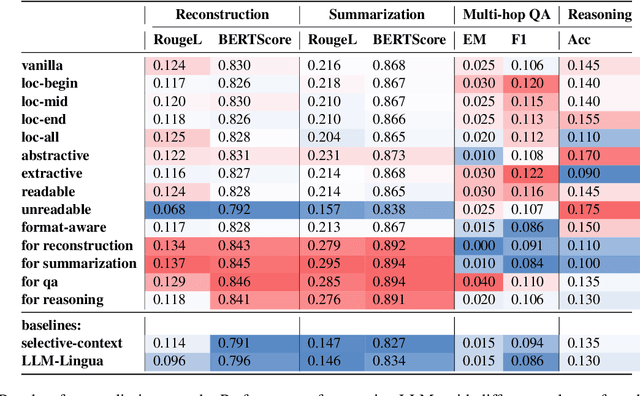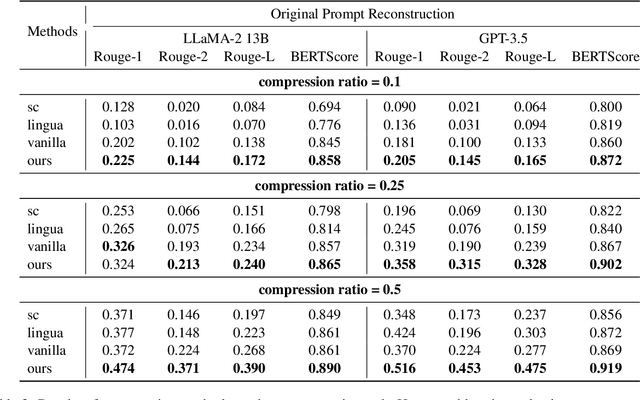Xiao Pu
$B^4$: A Black-Box Scrubbing Attack on LLM Watermarks
Nov 02, 2024Abstract:Watermarking has emerged as a prominent technique for LLM-generated content detection by embedding imperceptible patterns. Despite supreme performance, its robustness against adversarial attacks remains underexplored. Previous work typically considers a grey-box attack setting, where the specific type of watermark is already known. Some even necessitates knowledge about hyperparameters of the watermarking method. Such prerequisites are unattainable in real-world scenarios. Targeting at a more realistic black-box threat model with fewer assumptions, we here propose $\mathcal{B}^4$, a black-box scrubbing attack on watermarks. Specifically, we formulate the watermark scrubbing attack as a constrained optimization problem by capturing its objectives with two distributions, a Watermark Distribution and a Fidelity Distribution. This optimization problem can be approximately solved using two proxy distributions. Experimental results across 12 different settings demonstrate the superior performance of $\mathcal{B}^4$ compared with other baselines.
Style-Compress: An LLM-Based Prompt Compression Framework Considering Task-Specific Styles
Oct 17, 2024



Abstract:Prompt compression condenses contexts while maintaining their informativeness for different usage scenarios. It not only shortens the inference time and reduces computational costs during the usage of large language models, but also lowers expenses when using closed-source models. In a preliminary study, we discover that when instructing language models to compress prompts, different compression styles (e.g., extractive or abstractive) impact performance of compressed prompts on downstream tasks. Building on this insight, we propose Style-Compress, a lightweight framework that adapts a smaller language model to compress prompts for a larger model on a new task without additional training. Our approach iteratively generates and selects effective compressed prompts as task-specific demonstrations through style variation and in-context learning, enabling smaller models to act as efficient compressors with task-specific examples. Style-Compress outperforms two baseline compression models in four tasks: original prompt reconstruction, text summarization, multi-hop QA, and CoT reasoning. In addition, with only 10 samples and 100 queries for adaptation, prompts compressed by Style-Compress achieve performance on par with or better than original prompts at a compression ratio of 0.25 or 0.5.
Better than Random: Reliable NLG Human Evaluation with Constrained Active Sampling
Jun 12, 2024Abstract:Human evaluation is viewed as a reliable evaluation method for NLG which is expensive and time-consuming. To save labor and costs, researchers usually perform human evaluation on a small subset of data sampled from the whole dataset in practice. However, different selection subsets will lead to different rankings of the systems. To give a more correct inter-system ranking and make the gold standard human evaluation more reliable, we propose a Constrained Active Sampling Framework (CASF) for reliable human judgment. CASF operates through a Learner, a Systematic Sampler and a Constrained Controller to select representative samples for getting a more correct inter-system ranking.Experiment results on 137 real NLG evaluation setups with 44 human evaluation metrics across 16 datasets and 5 NLG tasks demonstrate CASF receives 93.18% top-ranked system recognition accuracy and ranks first or ranks second on 90.91% of the human metrics with 0.83 overall inter-system ranking Kendall correlation.Code and data are publicly available online.
Stumbling Blocks: Stress Testing the Robustness of Machine-Generated Text Detectors Under Attacks
Feb 18, 2024Abstract:The widespread use of large language models (LLMs) is increasing the demand for methods that detect machine-generated text to prevent misuse. The goal of our study is to stress test the detectors' robustness to malicious attacks under realistic scenarios. We comprehensively study the robustness of popular machine-generated text detectors under attacks from diverse categories: editing, paraphrasing, prompting, and co-generating. Our attacks assume limited access to the generator LLMs, and we compare the performance of detectors on different attacks under different budget levels. Our experiments reveal that almost none of the existing detectors remain robust under all the attacks, and all detectors exhibit different loopholes. Averaging all detectors, the performance drops by 35% across all attacks. Further, we investigate the reasons behind these defects and propose initial out-of-the-box patches to improve robustness.
LLM-based NLG Evaluation: Current Status and Challenges
Feb 02, 2024Abstract:Evaluating natural language generation (NLG) is a vital but challenging problem in artificial intelligence. Traditional evaluation metrics mainly capturing content (e.g. n-gram) overlap between system outputs and references are far from satisfactory, and large language models (LLMs) such as ChatGPT have demonstrated great potential in NLG evaluation in recent years. Various automatic evaluation methods based on LLMs have been proposed, including metrics derived from LLMs, prompting LLMs, and fine-tuning LLMs with labeled evaluation data. In this survey, we first give a taxonomy of LLM-based NLG evaluation methods, and discuss their pros and cons, respectively. We also discuss human-LLM collaboration for NLG evaluation. Lastly, we discuss several open problems in this area and point out future research directions.
On the Zero-Shot Generalization of Machine-Generated Text Detectors
Oct 08, 2023Abstract:The rampant proliferation of large language models, fluent enough to generate text indistinguishable from human-written language, gives unprecedented importance to the detection of machine-generated text. This work is motivated by an important research question: How will the detectors of machine-generated text perform on outputs of a new generator, that the detectors were not trained on? We begin by collecting generation data from a wide range of LLMs, and train neural detectors on data from each generator and test its performance on held-out generators. While none of the detectors can generalize to all generators, we observe a consistent and interesting pattern that the detectors trained on data from a medium-size LLM can zero-shot generalize to the larger version. As a concrete application, we demonstrate that robust detectors can be built on an ensemble of training data from medium-sized models.
Summarization is (Almost) Dead
Sep 18, 2023



Abstract:How well can large language models (LLMs) generate summaries? We develop new datasets and conduct human evaluation experiments to evaluate the zero-shot generation capability of LLMs across five distinct summarization tasks. Our findings indicate a clear preference among human evaluators for LLM-generated summaries over human-written summaries and summaries generated by fine-tuned models. Specifically, LLM-generated summaries exhibit better factual consistency and fewer instances of extrinsic hallucinations. Due to the satisfactory performance of LLMs in summarization tasks (even surpassing the benchmark of reference summaries), we believe that most conventional works in the field of text summarization are no longer necessary in the era of LLMs. However, we recognize that there are still some directions worth exploring, such as the creation of novel datasets with higher quality and more reliable evaluation methods.
PRO-Face S: Privacy-preserving Reversible Obfuscation of Face Images via Secure Flow
Jul 18, 2023Abstract:This paper proposes a novel paradigm for facial privacy protection that unifies multiple characteristics including anonymity, diversity, reversibility and security within a single lightweight framework. We name it PRO-Face S, short for Privacy-preserving Reversible Obfuscation of Face images via Secure flow-based model. In the framework, an Invertible Neural Network (INN) is utilized to process the input image along with its pre-obfuscated form, and generate the privacy protected image that visually approximates to the pre-obfuscated one, thus ensuring privacy. The pre-obfuscation applied can be in diversified form with different strengths and styles specified by users. Along protection, a secret key is injected into the network such that the original image can only be recovered from the protection image via the same model given the correct key provided. Two modes of image recovery are devised to deal with malicious recovery attempts in different scenarios. Finally, extensive experiments conducted on three public image datasets demonstrate the superiority of the proposed framework over multiple state-of-the-art approaches.
Is Summary Useful or Not? An Extrinsic Human Evaluation of Text Summaries on Downstream Tasks
May 24, 2023Abstract:Research on automated text summarization relies heavily on human and automatic evaluation. While recent work on human evaluation mainly adopted intrinsic evaluation methods, judging the generic quality of text summaries, e.g. informativeness and coherence, our work focuses on evaluating the usefulness of text summaries with extrinsic methods. We carefully design three different downstream tasks for extrinsic human evaluation of summaries, i.e., question answering, text classification and text similarity assessment. We carry out experiments using system rankings and user behavior data to evaluate the performance of different summarization models. We find summaries are particularly useful in tasks that rely on an overall judgment of the text, while being less effective for question answering tasks. The results show that summaries generated by fine-tuned models lead to higher consistency in usefulness across all three tasks, as rankings of fine-tuned summarization systems are close across downstream tasks according to the proposed extrinsic metrics. Summaries generated by models in the zero-shot setting, however, are found to be biased towards the text classification and similarity assessment tasks, due to its general and less detailed summary style. We further evaluate the correlation of 14 intrinsic automatic metrics with human criteria and show that intrinsic automatic metrics perform well in evaluating the usefulness of summaries in the question-answering task, but are less effective in the other two tasks. This highlights the limitations of relying solely on intrinsic automatic metrics in evaluating the performance and usefulness of summaries.
Contextual Learning in Fourier Complex Field for VHR Remote Sensing Images
Oct 28, 2022Abstract:Very high-resolution (VHR) remote sensing (RS) image classification is the fundamental task for RS image analysis and understanding. Recently, transformer-based models demonstrated outstanding potential for learning high-order contextual relationships from natural images with general resolution (224x224 pixels) and achieved remarkable results on general image classification tasks. However, the complexity of the naive transformer grows quadratically with the increase in image size, which prevents transformer-based models from VHR RS image (500x500 pixels) classification and other computationally expensive downstream tasks. To this end, we propose to decompose the expensive self-attention (SA) into real and imaginary parts via discrete Fourier transform (DFT) and therefore propose an efficient complex self-attention (CSA) mechanism. Benefiting from the conjugated symmetric property of DFT, CSA is capable to model the high-order contextual information with less than half computations of naive SA. To overcome the gradient explosion in Fourier complex field, we replace the Softmax function with the carefully designed Logmax function to normalize the attention map of CSA and stabilize the gradient propagation. By stacking various layers of CSA blocks, we propose the Fourier Complex Transformer (FCT) model to learn global contextual information from VHR aerial images following the hierarchical manners. Universal experiments conducted on commonly used RS classification data sets demonstrate the effectiveness and efficiency of FCT, especially on very high-resolution RS images.
 Add to Chrome
Add to Chrome Add to Firefox
Add to Firefox Add to Edge
Add to Edge